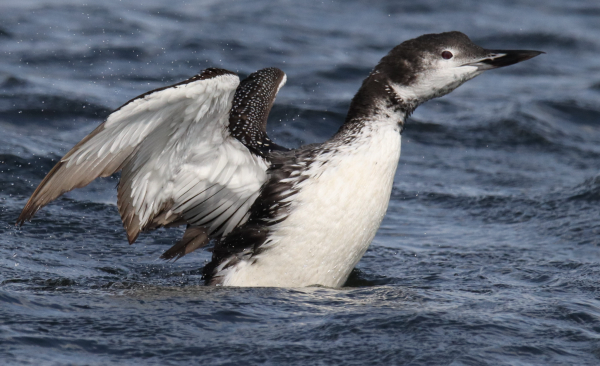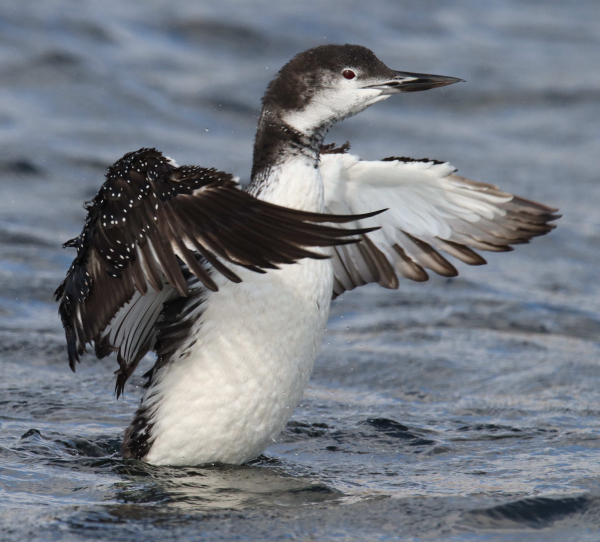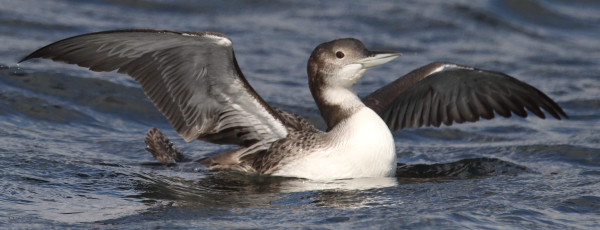
A chance to take action photos of the adult Common Loon during a break in its underwater fishing forays also revealed the extent of its molt into basic plumage – about 80 percent complete.

The adult loon provided 2 especially fruitful photo sessions close to the pontoon last Thursday during rough surface water conditions.

What fun to see the fledgling Common Loon’s wing feathers fully formed, and to witness its intense interest in fishing on its own, even when the adult paused.
|
As I approached my favorite Minnesota loon lake, the fall colors were dramatic in the deciduous woodlands, but there were white caps breaking on the water, white-capped waves created by a strong south wind in the 30 mile per hour range. After 3 weeks since my last visit, I wondered if the Common Loons would still be present, but hoped to photograph a molting or molted adult and check on the progress of its maturing fledgling. Once on the water, my friend Andy and I were excited to find the adult and fledgling we’ve been monitoring since July without delay.
From the beginning, as I tried photographing the loons it was evident that just keeping them in the photo frame was a new aspect of what would prove to be ‘big wave loon photography.’ The waves made the pontoon boat bounce up and down at a level that created a different kind of photo challenge, one I haven’t experienced in a long time, probably when photographing from a zodiac at sea. Even so, we certainly enjoyed spending time with the Common Loons, although they were intently engaged in fishing below the water’s surface most of the time.
Afterward, I was thrilled to see the best of the photos taken under the big wave conditions. As I said to Andy, I could photograph these loons all day every day – good thing I don’t live on a loon lake I guess. Even so, it sure is a thrill when I visit Andy for a loon photography session! You can refer to the whole story and some of the photos I took last Thursday in the Bird Photograph feature in this issue. I also produced a second feature to show the molting process of Common Loons, as they molt from alternate (breeding) plumage to basic (winter) plumage.
California Company
Not to let up after a full day of birding on Thursday, Friday warranted an extended birding session when my friend Kristine verified she would stop by to join me for an afternoon of birding fun. Although we didn’t make any outstanding observations, we enjoyed seeing American Avocets, Belted Kingfishers in 2 different locations, a recently fledged Red-headed Woodpecker, an adult Bald Eagle, some surprise Pine Siskins, plus Yellow-rumped Warblers, Northern Flickers, a small flock of Western Meadowlarks, a couple Northern Harriers, and widely scattered Red-tailed Hawks.
At Charo Marsh we had a standout American Pipit, along with about a dozen Lesser Yellowlegs, 5 Greater Yellowlegs, more than 40 Killdeer, 3 Wilson’s Snipe, a few Least Sandpipers, and 2 White-rumped Sandpipers that may have been lifers for Kristine. There were also many Blue-winged Teal and Gadwalls among the ducks in eclipse plumage, a sprinkling of White Pelicans, Double-crested Cormorants, Great Egrets, and Great Blue Herons, along with many American Coots and a few Pied-billed Grebes.
Unlike my loon escapades the day before, it was a beautiful windless day with a perfect 75 degree temperature, so we made it a point to take a couple walks and get outside the car as often as possible to enjoy the ultra-fresh air and the beauty of fall on the open prairie. Coming from San Jose, in the Bay Area of California, Kristine reveled in the chance to be in the quiet wide open spaces devoid of traffic and about as far away from even a little rural town as you can get (20 miles or more). The best walk we took was through and around a songbird migration hotspot (a sometimes hotspot, usually during spring). After the strong south winds the day before, I figured most songbirds had vacated, but there were a few Yellow-rumped Warblers working the colorful trees, and the sighting of a lone American Robin flying to the north cascaded into an ever-growing flock of more than 50 robins.
On the way home, we stopped on the escarpment on the eastern edge of the Missouri Coteau, where we had an expansive view after the sun set behind us. There we awaited the moonrise – a full super moon that Kristine was convinced would be an orange harvest moon. We absorbed the quiet, broken only by what must have been a flock of Western Meadowlarks that sang from all directions around us. The air was so fresh, and you could feel the temperature change as it cooled; Canada Geese called in the distance, Coyotes too; but where’s the moon? It was getting dark, the wildlife became silent, and the moon should be rising by now. At first, the only small thin cloud brightened up near the eastern horizon, but in moments the big yeller super moon beamed into the late September evening, spreading its moonglow across the Dakota plain.
Windy Weekend
The rest of the weekend was especially windy, but it was fun to see occasional Tennessee Warblers foraging their way through the trees outside my bay windows as I worked on this issue Saturday. A young Chipping Sparrow also joined the White-breasted Nuthatches at my hopper feeder to eat shelled sunflower seeds – a first, although Chippers have been irregular as ground foragers in my yard. During a short drive south of my office I stopped to watch an adult Swainson’s Hawk hunting on the wing in an almost stationary position as it caught a stout updraft above a prominent hillside. I expect any remaining Swainson’s Hawks will evacuate the northern plains in the next week; few are seen here beyond the first of October as they begin their long migration south across Texas, Mexico, Panama, Columbia, and over the Amazon basin to the pampas grasslands of northern Argentina where they spend the winter feeding on locusts, grasshoppers, and small rodents, sometimes in loose flocks.
Monday morning a warbler caught my attention among the sumac leaves that turned from yellow and orange to bright red overnight. It proved to be an Orange-crowned Warbler, and just as I viewed a second one, the first Hairy Woodpecker of the season (a male) arrived to select shelled sunflower seeds from my feeder, as did White-breasted Nuthatches during periods of the day.
In the field, I hoped more birds would reveal themselves during a day of lulled wind, but for the most part, birds sighted Sunday and Monday were very similar to the species that Kristine and I observed Friday, although there were scattered flocks of mixed gulls – Franklin’s and Ring-billed and no kingfishers or Swainson’s Hawks. Even so, changes in wind direction and new weather fronts passing through should bring new migration pulses – I’ll keep you posted. At the same time, enjoy the birds of October as we look forward to an active fall birding season.
Article and photos by Paul Konrad
Share your bird sightings and photographs at editorstbw2@gmail.com